For the 2025 school year, there are 3 public elementary schools serving 1,231 students in Washington Unified School District. This district's average elementary testing ranking is 2/10, which is in the bottom 50% of public elementary schools in California.
Public Elementary Schools in Washington Unified School District have an average math proficiency score of 15% (versus the California public elementary school average of 35%), and reading proficiency score of 25% (versus the 45% statewide average).
Minority enrollment is 95% of the student body (majority Hispanic), which is more than the California public elementary school average of 79% (majority Hispanic).
Overview
This School District
This State (CA)
# Schools
7 Schools
7,700 Schools
# Students
2,448 Students
3,822,920 Students
# Teachers
123 Teachers
174,006 Teachers
Student : Teacher Ratio
20:1
20:1
District Rank
Washington Unified School District, which is ranked #1493 of all 1,925 school districts in California (based off of combined math and reading proficiency testing data) for the 2021-2022 school year.
The school district's graduation rate of 82% has decreased from 83% over five school years.
Overall District Rank
#1512 out of 1941 school districts
(Bottom 50%)
(Bottom 50%)
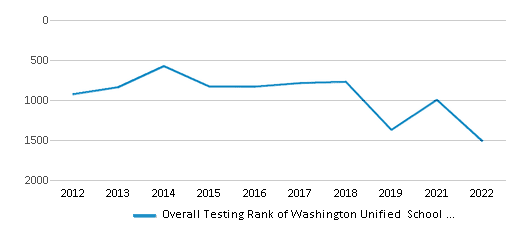
Math Test Scores (% Proficient)
14%
33%
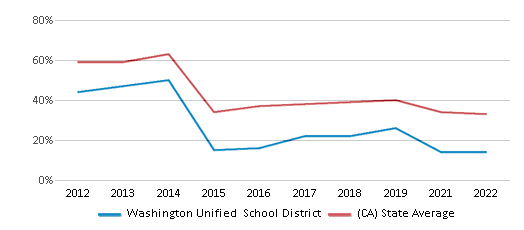
Reading/Language Arts Test Scores (% Proficient)
33%
47%
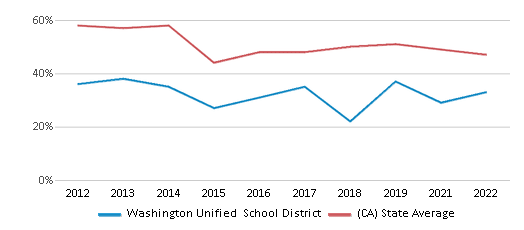
Science Test Scores (% Proficient)
14%
29%

Graduation Rate
82%
87%
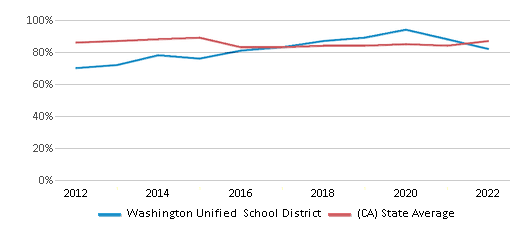
Students by Ethnicity:
Diversity Score
0.37
0.64
# American Indian Students
9 Students
16,785 Students
% American Indian Students
n/a
1%
# Asian Students
186 Students
454,357 Students
% Asian Students
8%
12%
# Hispanic Students
1,928 Students
2,114,366 Students
% Hispanic Students
79%
55%
# Black Students
137 Students
189,461 Students
% Black Students
6%
5%
# White Students
127 Students
787,389 Students
% White Students
5%
21%
# Hawaiian Students
4 Students
15,077 Students
% Hawaiian Students
n/a
n/a
# Two or more races Students
56 Students
240,557 Students
% of Two or more races Students
2%
6%
Students by Grade:
# Students in PK Grade:
-
83
# Students in K Grade:
150
519,574
# Students in 1st Grade:
127
396,601
# Students in 2nd Grade:
125
414,466
# Students in 3rd Grade:
139
416,628
# Students in 4th Grade:
139
426,360
# Students in 5th Grade:
131
430,582
# Students in 6th Grade:
125
432,936
# Students in 7th Grade:
137
312,207
# Students in 8th Grade:
158
312,649
# Students in 9th Grade:
281
44,929
# Students in 10th Grade:
312
37,487
# Students in 11th Grade:
325
37,249
# Students in 12th Grade:
299
41,169
# Ungraded Students:
-
-
District Revenue and Spending
The revenue/student of $19,341 in this school district is less than the state median of $19,974. The school district revenue/student has stayed relatively flat over four school years.
The school district's spending/student of $16,194 is less than the state median of $18,396. The school district spending/student has stayed relatively flat over four school years.
Total Revenue
$47 MM
$116,387 MM
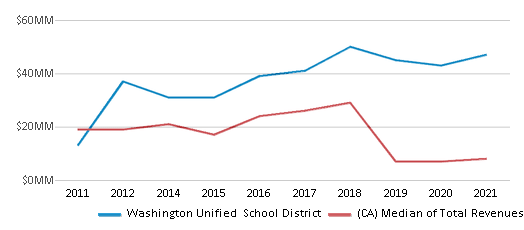
Spending
$40 MM
$107,188 MM
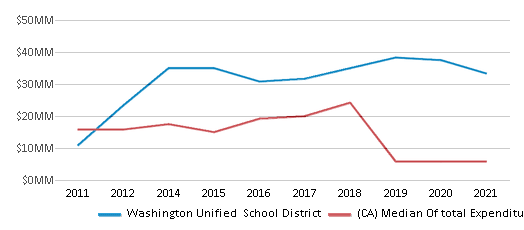
Revenue / Student
$19,341
$19,974
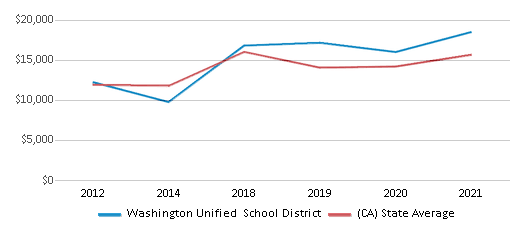
Spending / Student
$16,194
$18,396

Best Washington Unified School District Public Elementary Schools (2025)
School
(Math and Reading Proficiency)
(Math and Reading Proficiency)
Location
Grades
Students
Rank: #11.
American Union Elementary School
(Math: 26% | Reading: 37%)
Rank:
Rank:
5/
Bottom 50%10
2801 West Adams Ave.
Fresno, CA 93706
(559) 495-5650
Fresno, CA 93706
(559) 495-5650
Grades: K-8
| 291 students
Rank: #22.
West Fresno Elementary School
(Math: 13% | Reading: 21%)
Rank:
Rank:
2/
Bottom 50%10
2910 South Ivy St.
Fresno, CA 93706
(559) 495-5615
Fresno, CA 93706
(559) 495-5615
Grades: K-5
| 627 students
Rank: #33.
West Fresno Middle School
(Math: 11% | Reading: 22%)
Rank:
Rank:
2/
Bottom 50%10
2888 South Ivy St.
Fresno, CA 93706
(559) 495-5607
Fresno, CA 93706
(559) 495-5607
Grades: 6-8
| 313 students
Recent Articles

Year-Round Or Traditional Schedule?
Which is more appropriate for your child? A year-round attendance schedule or traditional schedule? We look at the pros and cons.

Why You Should Encourage Your Child to Join a Sports Team
Participating in team sports has a great many benefits for children, there is no doubt. In this article you will learn what those benefits are.

White Students are Now the Minority in U.S. Public Schools
Increasing birth rates among immigrant families from Asia and Central and South America, combined with lower birth rates among white families, means that for the first time in history, public school students in the United States are majority-minority. This shift in demographics poses difficulties for schools as they work to accommodate children of varying language abilities and socio-economic backgrounds.





